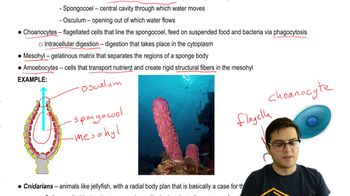31. Invertebrates
Porifera and Cnideria
Learn with other creators
Practice this topic
- Multiple ChoiceSponges feed by __________.1456views1rank
- Multiple ChoiceSponges lack __________.1282views
- Multiple ChoiceSome digestion in sponges takes place in the __________.1487views
- Multiple ChoiceWhich of the following is/are characteristic of sponges?2327views
- Textbook QuestionWhich of these characteristics does not apply to cnidarians?a. are diploblasticb. possess a gastrovascular cavity with one openingc. undergo metamorphosisd. have a central nervous system1303views
- Textbook Question
Jon found an organism in a pond, and he thinks it's a freshwater sponge. His friend Liz thinks it looks more like an aquatic fungus. How can they decide whether it is an animal or a fungus?
a. See if it can swim.
b. Figure out whether it is autotrophic or heterotrophic.
c. See if it is a eukaryote or a prokaryote.
d. Look for cell walls under a microscope.
745views - Textbook Question
Which of these characteristics does not apply to cnidarians?
a. Are diploblastic
b. Possess a gastrovascular cavity with one opening
c. Undergo metamorphosis
d. Have a central nervous system
517views - Textbook Question
Which of these choices is an example of homology (similarity due to common ancestry)?
a. Suspension feeding in sponges and clams
b. Ectoparasite lifestyle in aphids and ticks
c. Cnidocytes (stinging cells) in jellyfish and sea anemones
d. Radial symmetry in cnidarians and echinoderms
808views







